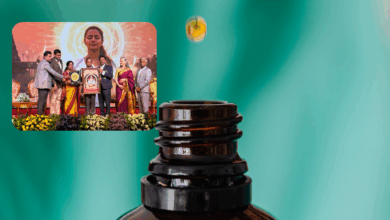Only the right Centella asiatica proves effective
 At times ‘Medhya Rasayana’ used as brain tonic in Ayurveda or Dermaxime face creams or the ‘Vallari lehyam’ used in Siddha had little effect , while for others it was every effective? Well, it could all boil down to the variety of centella, a herb with a creeping stem used in the preparation, a team of scientists from the Tropical Botanic Garden and Research Institute (TBGRI) at Palode, near here, has found. An ingredient of medications in traditional systems of medicine such as Ayurveda, Siddha and Unani, centella is used to treat an array of ailments such as ulcer, tumour, filariasis, leprosy, dysentery, cholera, diarrhoea, also for wound healing, scar management and as a constituent of brain tonics for the mentally retarded. However, products using these plants showed a whole lot of difference in effectiveness. In a paper recently published in the Journal of Industrial Crops and Products, the TBGRI team of M T Thomas, Rajani Kurup, Anil John Johnson, Sreeja Purushothaman Chandrika, Paravanparampil Jacob Mathew, Mathew Dan and Sabulal Baby have said that different varieties of the same plant have different amounts of the key medicinal compounds. “The medicinal properties of centella are mainly due to four compounds they contain, out of which one called asiaticoside has been identified with its wound-healing properties and another called madecacosside with burn wound-healing properties. Asiaticoside is also used in cosmaceutic applications,’’ said P J Mathew, scientist at TBGRI, who was part of the team that conducted the study. The TBGRI team has found that some plants have very low or nil concentrations of one or the other of the two active compounds, while some others may have very high content. ‘’We found the genotype from Ooty to have highest asiaticoside content, while those from Top Station in Munnar showed the highest madecosside content. The genotype from Nanora in Goa had neither of these compounds,’’ said P J Mathew. The team had collected plants from various places in South India and Andaman islands, including Kolhapur, Bison Valley, Alwaye, North Goa, Nepal and Ooty, among others. Most of the collectors of this plant, commonly known as Indian pennywort, assume that all plants have the same content of active compounds and collect these plants from wherever they find them. This can lead to overexploitation and a probable wipe out of centella genotypes in future. Centella asiatica is seen throughout the tropics and it occurs all over India from plains to hill ranges, propagating through sexual and vegetative means. ‘’The varieties of Centella asiatica discovered in this study could be cultivated and utilised in traditional medicine. This could reduce the uncontrolled collection of Centella asiatica from the wild as well as prevent elimination of certain genotypes,’’ said Mathew. ‘’It also helps to understand the biochemical pathway by which these compounds can be produced artificially,’’ explained Mathew. So the next time, if a cosmetic product using centella does not work, don’t blame the manufacturers, blame the plant itself!
At times ‘Medhya Rasayana’ used as brain tonic in Ayurveda or Dermaxime face creams or the ‘Vallari lehyam’ used in Siddha had little effect , while for others it was every effective? Well, it could all boil down to the variety of centella, a herb with a creeping stem used in the preparation, a team of scientists from the Tropical Botanic Garden and Research Institute (TBGRI) at Palode, near here, has found. An ingredient of medications in traditional systems of medicine such as Ayurveda, Siddha and Unani, centella is used to treat an array of ailments such as ulcer, tumour, filariasis, leprosy, dysentery, cholera, diarrhoea, also for wound healing, scar management and as a constituent of brain tonics for the mentally retarded. However, products using these plants showed a whole lot of difference in effectiveness. In a paper recently published in the Journal of Industrial Crops and Products, the TBGRI team of M T Thomas, Rajani Kurup, Anil John Johnson, Sreeja Purushothaman Chandrika, Paravanparampil Jacob Mathew, Mathew Dan and Sabulal Baby have said that different varieties of the same plant have different amounts of the key medicinal compounds. “The medicinal properties of centella are mainly due to four compounds they contain, out of which one called asiaticoside has been identified with its wound-healing properties and another called madecacosside with burn wound-healing properties. Asiaticoside is also used in cosmaceutic applications,’’ said P J Mathew, scientist at TBGRI, who was part of the team that conducted the study. The TBGRI team has found that some plants have very low or nil concentrations of one or the other of the two active compounds, while some others may have very high content. ‘’We found the genotype from Ooty to have highest asiaticoside content, while those from Top Station in Munnar showed the highest madecosside content. The genotype from Nanora in Goa had neither of these compounds,’’ said P J Mathew. The team had collected plants from various places in South India and Andaman islands, including Kolhapur, Bison Valley, Alwaye, North Goa, Nepal and Ooty, among others. Most of the collectors of this plant, commonly known as Indian pennywort, assume that all plants have the same content of active compounds and collect these plants from wherever they find them. This can lead to overexploitation and a probable wipe out of centella genotypes in future. Centella asiatica is seen throughout the tropics and it occurs all over India from plains to hill ranges, propagating through sexual and vegetative means. ‘’The varieties of Centella asiatica discovered in this study could be cultivated and utilised in traditional medicine. This could reduce the uncontrolled collection of Centella asiatica from the wild as well as prevent elimination of certain genotypes,’’ said Mathew. ‘’It also helps to understand the biochemical pathway by which these compounds can be produced artificially,’’ explained Mathew. So the next time, if a cosmetic product using centella does not work, don’t blame the manufacturers, blame the plant itself!
Source : IBN Live


